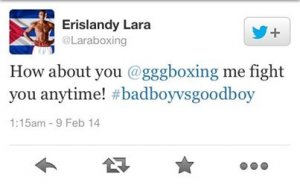Pacquiao offers Bradley second chance at defining the Desert Storm legacy
By Stephen Lynch
Bereft of options, Manny Pacquiao is about to repeat the same mistake he made in 2012 in challenging Timothy Bradley to a rematch. Sympathetic judges, debilitating injuries or one concussive punch from the Pacman are the only ways he can win this second fight. Giving a “thinking fighter” like Bradley a second opportunity to figure you out is like going to rob the same bank you did last week using the exact same method, the exact same crew and even wearing the same outfits and disguises.
All credit to Filipino’s national hero for taking on this difficult assignment again – even though this time around he is left with a far shorter list of viable opponents – but it is a fight he simply can’t win. If it goes the distance like the first bout, the commentariat wisdom is that Bradley will have thoroughly outboxed Pacquiao. Having worked out the angles, timed the incoming punches, limited his prior mistakes and made the adjustments to counter and strike at the legendary southpaw, Bradley will deconstruct Pacquiao in similar fashion to Juan Manuel Marquez over four engrossing fights.
Controversial scoring aside, “Desert Storm” Bradley recovered from a twisted right ankle and a fractured left foot to fight through the pain barrier and see out the rest of the fight on his feet. Again, while most thought Pacquiao won by at least two or three rounds (including me at first viewing) – all three judges gave the American round seven and two of the three handed him the last three rounds of the bout. This was a competitive, close fight folks – ignore the hyperbole from HBO’s biased team of Lampley and Merchant that night – Emmanuel Steward was the only one calling the action down the middle and watching without rose-tinted spectacles.
Gamblers Advisory’s Richard Dwyer sets out two broad types of fighter in boxing; “Pattern” fighters such as Wladimir Klitschko, Ricky Hatton and Manny Pacquiao contrasted with “Adaptive-reactive” fighters who count Floyd Mayweather, Bernard Hopkins and Andre Ward among their class. Tim Bradley belongs to the latter grouping. He is also one of those boxers, like Danny Garcia, who has no obvious exceptional quality or attribute, but is very able across a wide range of competences including foot speed, hand speed, counterpunching, combinations, inside fighting skill, punch resistance, ring generalship and IQ.
If the elusive Mayweather-Pacquiao fight wasn’t killed off when Bradley won the split decision in April 2012 then I expect it to be on April 12 2014 when Bradley wins a much wider decision. Although Pacquiao is 35 years old now, power is the last thing to leave an aging boxer, and he has a decent puncher’s chance in whatever fight he’s in. The only question is how much Desert Storm will engage with and trade with Pacman if the bullets start flying. The WBO champion has said he’d be willing to have a shootout, no doubt as a show of bravado if not a misdirecting tactic. Freddie Roach doesn’t expect such brawling fireworks from the unbeaten Californian, telling reporters they are planning to cut off the ring and aggressively back Bradley into a corner. Roach added that “once he gets hit he’ll fight back and he’ll become his old self.” Is this archetypal Tim Bradley the same who got into the trenches with Ruslan Provodnikov in the Fight of the Year? Or the more conservative outfoxing and outsmarting of the wily Juan Manuel Marquez?
Tim Bradley already has a knowledge base on fighting Pacquiao, 12 rounds at that, after surviving the stormy early rounds and appearing to begin solving the Pacquiao puzzle. He also admitted in the press conference last week to having studied his foe “forever.” But if in some parallel universe Pacquiao was to fight Floyd Mayweather, a notoriously slow-starter, he’d surely have a greater chance of stopping the unbeaten RING/WBC champion. Zab Judah, Ricky Hatton and Shane Mosley all had their greatest success against Floyd in the earlier rounds – such is the small window of opportunity that presents itself to his opponents. This window closes almost as soon as it opens, once Mayweather recognises the chink in his armour and adapts his game to conceal it again like a shape-shifting chameleon.
Bradley is a tough competitor, an exemplary athlete, a dangerous opponent and fiendishly difficult to beat the first time, never mind having to do it a second time. To borrow another analogy from Dwyer; if you’re in the ring with a safe-cracker – the last thing you want to do is to give them your combination. “The Fighting Congressman” is handing such information to Tim Bradley, whose determination will drive him to take full advantage of the blueprint.
Keen to prove it wasn’t a fluke the first time around, Bradley seeks an exclamation mark to his Pacquiao predicament. Speaking often of the chip on his shoulder sustained by his critics, and how he uses these to motivate himself to train “like an animal” – Bradley is on a mission to prove us all wrong. A clear victory here would further enhance his formidable legacy, and would see him replace his Top Rank stablemate as the public’s crowned challenger to Mayweather’s throne. But there is a real sense that their lanes will not cross, in the same way Pacquiao’s never did. Promoter politics and network disputes notwithstanding, boxing historians will look back on this period and lament the failure of the “Mayweather-Pacquiao-Bradley” Era to materialise. We have the next best thing to look forward to on April 12.




